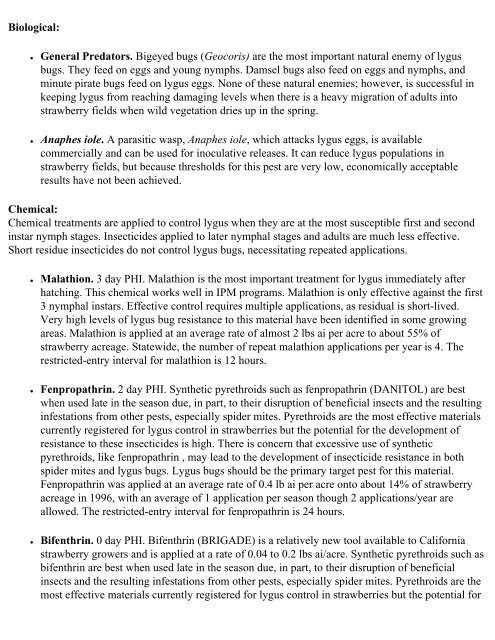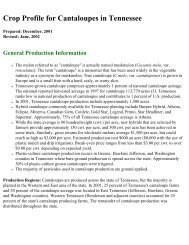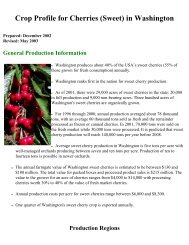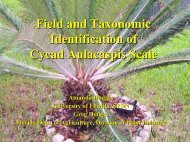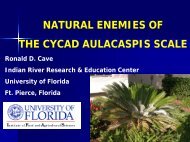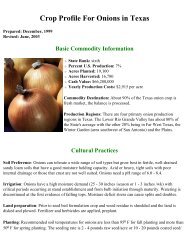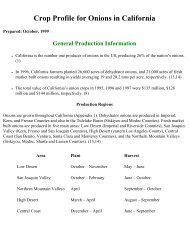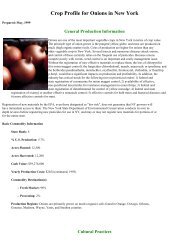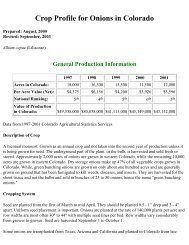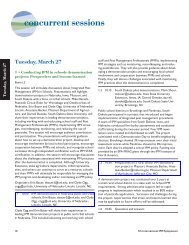Crop Profile for Strawberries in California - Regional IPM Centers
Crop Profile for Strawberries in California - Regional IPM Centers
Crop Profile for Strawberries in California - Regional IPM Centers
Create successful ePaper yourself
Turn your PDF publications into a flip-book with our unique Google optimized e-Paper software.
Biological:<br />
● General Predators. Bigeyed bugs (Geocoris) are the most important natural enemy of lygus<br />
bugs. They feed on eggs and young nymphs. Damsel bugs also feed on eggs and nymphs, and<br />
m<strong>in</strong>ute pirate bugs feed on lygus eggs. None of these natural enemies; however, is successful <strong>in</strong><br />
keep<strong>in</strong>g lygus from reach<strong>in</strong>g damag<strong>in</strong>g levels when there is a heavy migration of adults <strong>in</strong>to<br />
strawberry fields when wild vegetation dries up <strong>in</strong> the spr<strong>in</strong>g.<br />
● Anaphes iole. A parasitic wasp, Anaphes iole, which attacks lygus eggs, is available<br />
commercially and can be used <strong>for</strong> <strong>in</strong>oculative releases. It can reduce lygus populations <strong>in</strong><br />
strawberry fields, but because thresholds <strong>for</strong> this pest are very low, economically acceptable<br />
results have not been achieved.<br />
Chemical:<br />
Chemical treatments are applied to control lygus when they are at the most susceptible first and second<br />
<strong>in</strong>star nymph stages. Insecticides applied to later nymphal stages and adults are much less effective.<br />
Short residue <strong>in</strong>secticides do not control lygus bugs, necessitat<strong>in</strong>g repeated applications.<br />
● Malathion. 3 day PHI. Malathion is the most important treatment <strong>for</strong> lygus immediately after<br />
hatch<strong>in</strong>g. This chemical works well <strong>in</strong> <strong>IPM</strong> programs. Malathion is only effective aga<strong>in</strong>st the first<br />
3 nymphal <strong>in</strong>stars. Effective control requires multiple applications, as residual is short-lived.<br />
Very high levels of lygus bug resistance to this material have been identified <strong>in</strong> some grow<strong>in</strong>g<br />
areas. Malathion is applied at an average rate of almost 2 lbs ai per acre to about 55% of<br />
strawberry acreage. Statewide, the number of repeat malathion applications per year is 4. The<br />
restricted-entry <strong>in</strong>terval <strong>for</strong> malathion is 12 hours.<br />
● Fenpropathr<strong>in</strong>. 2 day PHI. Synthetic pyrethroids such as fenpropathr<strong>in</strong> (DANITOL) are best<br />
when used late <strong>in</strong> the season due, <strong>in</strong> part, to their disruption of beneficial <strong>in</strong>sects and the result<strong>in</strong>g<br />
<strong>in</strong>festations from other pests, especially spider mites. Pyrethroids are the most effective materials<br />
currently registered <strong>for</strong> lygus control <strong>in</strong> strawberries but the potential <strong>for</strong> the development of<br />
resistance to these <strong>in</strong>secticides is high. There is concern that excessive use of synthetic<br />
pyrethroids, like fenpropathr<strong>in</strong> , may lead to the development of <strong>in</strong>secticide resistance <strong>in</strong> both<br />
spider mites and lygus bugs. Lygus bugs should be the primary target pest <strong>for</strong> this material.<br />
Fenpropathr<strong>in</strong> was applied at an average rate of 0.4 lb ai per acre onto about 14% of strawberry<br />
acreage <strong>in</strong> 1996, with an average of 1 application per season though 2 applications/year are<br />
allowed. The restricted-entry <strong>in</strong>terval <strong>for</strong> fenpropathr<strong>in</strong> is 24 hours.<br />
● Bifenthr<strong>in</strong>. 0 day PHI. Bifenthr<strong>in</strong> (BRIGADE) is a relatively new tool available to Cali<strong>for</strong>nia<br />
strawberry growers and is applied at a rate of 0.04 to 0.2 lbs ai/acre. Synthetic pyrethroids such as<br />
bifenthr<strong>in</strong> are best when used late <strong>in</strong> the season due, <strong>in</strong> part, to their disruption of beneficial<br />
<strong>in</strong>sects and the result<strong>in</strong>g <strong>in</strong>festations from other pests, especially spider mites. Pyrethroids are the<br />
most effective materials currently registered <strong>for</strong> lygus control <strong>in</strong> strawberries but the potential <strong>for</strong>


